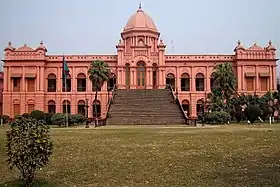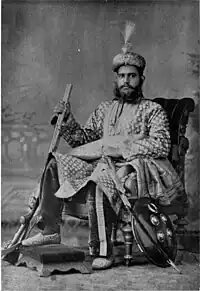| Nadia Raj | |
|---|---|
| Country | |
| Current region | Nadia, West Bengal, India |
| Founded | 17th century |
| Founder | Raja Bhabananda Majumdar[1] |
| Final ruler | Raja Ksitish Chandra Roy |
| Titles | |
| Dissolution | January 26, 1950 |
| Part of a series on |
| Zamindars of Bengal |
|---|
 |
Nadia Raj were a dynasty of Zamindars and the rulers of territories that are now part of the Nadia district region of West Bengal, India.[2] Their seat was at the city of Krishnanagar, Nadia.[3][4] The estate of Nadia Raj was estimated to cover an area of 8,161 square kilometres (3,151 sq mi).[5]
The rulers of Nadia Raj established many Sanskrit schools in Nadia, since they were the patron of Sanskrit literature and music. They were also patrons of Sanskrit culture in Bengal.[6]
History
The Nadia Raj family is descended from Bhatta Narayana,[7][8] who was a Kanyakubja Brahmin of the Sandilya Gotra. He was summoned from Kanyakubja (Kannauj) by Raja Adisura of Bengal, for the conduct of ceremonies of purification.[8]

The Nadia Raj family is one of the oldest Hindu families in Bengal, spanning more than 35 generations from the founder. Since the establishment of British rule in Bengal each of the Rajas of Nadia were created a Maharaja Bahadur in succession.[9]
List of rulers
Bhavananda Majumdar – 1606-1628
Gopal Roy – 1628-1632
Raghav Roy – 1632-1683
Rudra Roy – 1683-1694
Ramakrishna -- 1694
Ramjivan – 1694-1715
Raghuram – 1715-1728
Krishnachandra Roy – 1728-1782
Shivachandra – 1782-1788
Ishwarchandra – 1788-1802
Girijachandra – 1802-1842
Srishchandra – 1842-1856
Satishchandra – 1856-1870
References
- ↑ "Maharaja Krishnachandra Roy". Scribd.
- ↑ Varuni Bhatia (9 August 2017). Unforgetting Chaitanya: Vaishnavism and Cultures of Devotion in Colonial Bengal. Oxford University Press. p. 181. ISBN 978-0-19-068625-3. Retrieved 9 August 2017.
- ↑ P. J. Marshall (1987). Bengal: The British Bridgehead: Eastern India 1740-1828. Cambridge University Press. p. 16. ISBN 9780521253307. Retrieved 2 November 2006.
- ↑ Kunal Chakrabarti; Shubhra Chakrabarti (22 August 2013). Historical Dictionary of the Bengalis. Scarecrow Press. p. 327. ISBN 9780810880245. Retrieved 22 August 2013.
- ↑ Rachel Fell McDermott (28 June 2001). Mother of My Heart, Daughter of My Dreams: Kali and Uma in the Devotional Poetry of Bengal. Oxford University Press. p. 20. ISBN 978-0-19-803071-3. Retrieved 28 June 2001.
- ↑ M. Dodson (15 February 2007). Orientalism, Empire, and National Culture: India, 1770-1880. Springer. p. 49. ISBN 9780230288706. Retrieved 15 February 2007.
- ↑ Anne Murphy (12 March 2012). Time, History and the Religious Imaginary in South Asia. Routledge. p. 182. ISBN 9781136707292. Retrieved 12 March 2012.
- 1 2 "Did you know Nadia's original capital was Matiyari?". Retrieved 13 May 2020.
- ↑ Chowdhury, S. R. Kumar; P. K., Singh; Ismail, M. Ali (2012). Blood Dynasties: Zemindaris of Bengal - A Chronicle of Bengal's Ruling families (Paperback). Dictus: Politics and Democracy series. ISBN 9783847385080. Retrieved 17 March 2014.